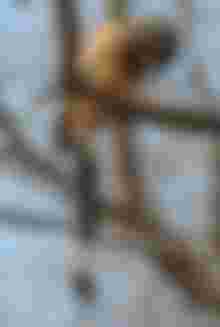Brown pot
(Scientific name: Dendrocitta vagabunda) or just pot A long-tailed bird of the genus Dendrocitta (Dendrocitta) of the genus Corvidae.
The scientific name for the brown pot is "vagabond tree doel" (Greek dendron = tree, kitta = dowel; Latin vagabunda = vagabond). They cover a vast area around the world, about 43 lakh 60 thousand square kilometers. Their numbers have remained unchanged over the past few decades.

That's why I. U.S. C. N. This species has been declared as Least Concern. This species is protected under the Wildlife Act of Bangladesh. In Bangladesh, the bird is locally known as Taura, Tare, Lejjhola, Dhenkilaja, Kutum Pakhi etc.
Scientific taxonomy
World: Animalia
Episode: Cordata
Category: Birds
Class: Passeriformes
Family: Corvidae
Mass: Dendrocitta
Species: D. vagabunda
Binomial name: Dendrocitta vagabunda (Latham, 1790)

Brown pots roam across South Asia and Southeast Asia. Bangladesh, India, Pakistan, Nepal, Bhutan, Myanmar, China, Thailand, Laos, Vietnam and Cambodia are the main habitats of this species. The bird has also been released in Singapore. A total of nine subspecies of brown pots have been identified. The subspecies are:
. D.v. bristoli (Paynter, 1961) - extends to Karachi in the east and south of Pakistan and from the foothills of the Himalayas to Dehradun.
.
D.v. vagabunda (Latham, 1790) - They extend from the eastern edge of Uttar Pradesh to Bangladesh and northeastern India and to the south by the Deccan and Andhra Pradesh.
D. v. behni (Steinheimer, 2009) - Their range is limited from South Gujarat (Surat) through Central and South Karnataka to the Western Ghats.
D. v. parvula (Whistler & Kinnear, 1932) - Their main distribution is throughout South Karnataka and Kerala.
D.v. pallida (Blyth, 1846) - Their main habitat is on the south bank of the Godavari River in the Eastern Ghats of southeastern India. .
D.v. sclateri (Stuart Baker, 1922) - They spread throughout northern and western Myanmar.
D. v. kinneari (Stuart Baker, 1922) - Spread across central and eastern Myanmar, southern China (southwestern Yunnan province) and northwestern Thailand.
D. v. saturatior (Ticehurst, 1922) - Their main habitat is southern Myanmar and southwestern Thailand.
D. v. sakeratensis (Gyldenstolpe, 1920) - They spread throughout central, eastern and southeastern Thailand, Cambodia, central Laos, and central and southern Vietnam.
An omnivorous bird with brown eyes, red eyes and a long tail. Their length is less than 50 cm, wings 15 cm, lips 3.2 cm, legs 3.3 cm and tail 23 cm. Weight 115 grams.

The back of the adult bird is reddish-brown. The lower part of the body is brown. The head, back of the neck and chest are dark-slate gray. The back of the body is red. Stomach and esophagus slightly yellow. The wings have been shown solely to give a sense of proportion. The wings have white or pale gray feathers from the base to the end. Its white stripe is clearly visible when flying.

Brown pot has black ribbons at the ends. Eyes orange-brown to slightly brownish red. The lips are strong. The color of the lips is dark-gray. The lower part of the base of the lip is relatively light. The legs and feet are dark brown. The appearance of female and male birds is identical. The head of the juvenile bird is relatively brown. In addition, the feather-cover of the wings has a yellowish tinge. The tip of the tail is pale yellow and the color of the face is matte.
Brown pots usually roam in open forests, forest edges, tree-lined areas, gardens, villages, roadside trees and even urban parks. Usually travels alone, in pairs or in family groups. Their pairing is quite strong. They live together year after year and reproduce. They look for food by turning leaves on deciduous trees or on the ground. They are rarely seen on the ground.

Their diet includes a variety of insects, ripe fruits, flower honey, invertebrates, frogs (more popular), small reptiles, small snakes, bats, rats, needles, squirrels, chicks and eggs and rotten meat.
When in danger, they eat earthworms, beetles, spiders, snails and ticks. They are not very good hunters. Occasionally hunts simultaneously through small groups of two members. In the world of birds, they are known as robber birds. Because they eat the eggs and chicks of other birds. In some cases it is common for them to chase birds.
Sometimes they call out loud: Kitar-Kitar-Kitar ...., Chatuk-Chuk-Chak-Chak ...., Mee-Au .... They call out in a hoarse voice. That is why somewhere in Bangladesh it is called Kanch Kanchcha.

March to July is their main breeding season. It takes one to three days to choose a place to stay. It takes 4-6 days to build a house. Both males and females build nests together. It nests in the forest with vines, stalks, bamboo twigs, leaves and roots. The house is round and untidy like a crow's nest. The height of the house is 6 to 8 meters above the ground.
When the nest is built, 4-5 eggs are laid. A wide variety of egg colors can be noticed. The color of the eggs is usually salmon-white. Green, jute, reddish and pink eggs are also seen. Eggs often have reddish brown spots. The eggs are slightly round in shape. The size of the egg is 2.9 × 2.1 cm. The eggs hatch in 18-19 days. Both parents are responsible for feeding the cubs. The chicks leave the house in 29-30 days.

Edit References:
Reza Khan, Birds of Bangladesh (Dhaka: Bangla Academy, 2007), p. 218.
Zia Uddin Ahmed (Ed.), Bangladesh Encyclopaedia of Plants and Animals: Birds, Volume: 26 (Dhaka: Bangladesh Asiatic Society, 2009), p. 328. ↑
Dendrocitta vagabunda, BirdLife International at the brown pottery page.
B Dendrocitta vagabunda, The IUCN Red List of Threatened Species ↑ A B C Sharif Khan, Birds of Bangladesh (Dhaka: Divyaprakash, 2012), p. 328. ↑
Rufous Treepie, The Internet Bird Collection. ↑ Baker, EC Stuart,
The Fauna of British India, Including Ceylon and Burma. Birds. Volume 1, (London: Taylor and Francis, 1922), pp. 48–52.









In community: We are Bangladeshi(1bc0) Brown pot (Scientific name: Dendrocitta vagabunda) or just pot A long-tailed bird of the genus Dendrocitta (Dendrocitta) of the genus Corvidae. The scientific name for the brown pot is "vagabond tree doel" (Greek dendron = tree, kitta = dowel; Latin vagabunda = vagabond). They cover a vast area around the world, about 43 lakh 60 thousand square kilometers. Their numbers have remained unchanged over the past few decades.
That's why I. U.S. C. N. This species has been declared as Least Concern. This species is protected under the Wildlife Act of Bangladesh. In Bangladesh, the bird is locally known as Taura, Tare, Lejjhola, Dhenkilaja, Kutum Pakhi etc.